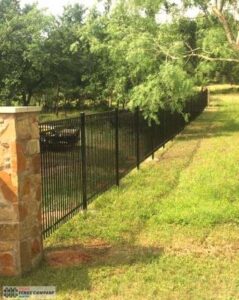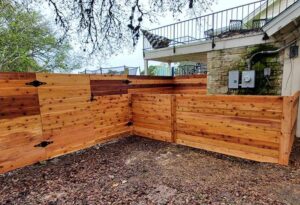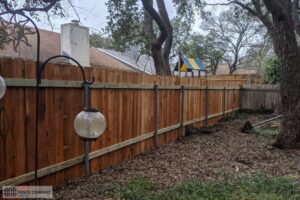Austin Heat & UV: Stain Formulations That Don’t Fry by Year Two
TL;DR
Austin’s sun is brutal on wood. If your stain chalks, fades, or peels by year two, it’s usually because of (1) the wrong resin chemistry, (2) weak UV pigments, (3) film-forming products that cook on south/west exposures, or (4) poor prep/application in hot, dry air. The long-term winners are penetrating, oil-rich or alkyd-modified stains with nanopigment/iron-oxide packages, applied to dry cedar, back-brushed, and finished before surfaces exceed ~90–95°F. Choose mid-tone, UV-stable stain colors, maintain on a realistic cadence, and your fence will look good past the two-year mark. If you want a dialed-in spec for your exact yard, the team at Atlas Fence Company can test, prep, and stain it right the first time.
Table of Contents
ToggleWhy Austin Kills Stain So Fast

Two words: heat and UV. Summer deck temps routinely hit 140°F; vertical fences, especially on west- and south-facing sides, bake all afternoon. High UV index breaks down lignin in the top fiber layer, and heat accelerates resin oxidation. Add wind-blown grit from greenbelts plus sprinkler mineral deposits, and under-built stains chalk, fade, and peel early.
Common symptoms we see by month 18–24:
- Rapid fade on south/west runs (pigment package too weak).
- Chalking (UV-degraded binder turning powdery).
- Peeling (film-forming coatings blistering off hot boards).
- Blotchy darkening near sprinklers (water intrusion + minerals).
Austin requires chemistry that moves with the wood and resists UV, not a pretty can that behaves like indoor varnish.
Understand Stain Chemistry (Resins, Carriers, Solids)
Resins (the “glue” that survives UV)
- Penetrating oils (linseed, soya, modified alkyds): Soak into fiber, keep a low build, and weather gracefully. Alkyd-modified oils crosslink to improve longevity without forming a brittle shell.
- Water-borne acrylics: Great color options, faster dry, lower odor—but many form thin films. In the Austin heat, films age faster and can peel if the surface temperature at application is too high.
- Hybrids (oil-in-water emulsions): Offer oil penetration with water cleanup. Choose ones marketed as non-film-forming with high-quality alkyds.
Carriers & Solids
- Higher solids = more pigments/resin left in the wood when the carrier flashes off. Too-low solids cause the color to disappear quickly.
- Solvent vs water: A carrier alone doesn’t equal performance; the resin type and pigment load matter more.
Additives
UV absorbers + HALS (hindered amine light stabilizers) protect resins from chain scission (breaking) under UV exposure. Look for pro-grade products that call these out.
Bottom line: In Austin, pick penetrating systems with alkyd/oil richness, nanopigments (see next), HALS, and non-film claims right on the technical sheet.
UV Defense: Pigments, HALS & Optical Tricks
- Transparent iron-oxide (TIO) nanopigments: Tiny particles that scatter/absorb UV while letting visible light through, yielding rich color without a heavy, paint-like look.
- Carbon black & opaque pigments: Excellent UV blockers, but can look flat/industrial on fences if overused.
- HALS + UV absorbers: One absorbs the UV energy; the other scavenges free radicals that would otherwise chew up the binder. Together, they extend service life in our sun.
Think of these like sunglasses for your stained fences—no sunglasses, you squint by year two.
Color Science for Hot Sun (What Fades, What Lasts)
- Go mid-tone to darker naturals: Honey, chestnut, walnut, or redwood tones hide UV drift better than ultra-light “natural.”
- Avoid ultra-pale clears on west faces: Beautiful day one, ghosted by the second summer.
- Beware very dark near black on full-sun, south/west runs: They absorb heat like a skillet, accelerating oil oxidation and drying checks. If you want moody darks, choose a penetrating system with robust HALS and plan closer maintenance.
Pro tip: Stain a small, sunny offcut and leave it on the west side for two weeks. If it lightens or goes chalky quickly, the pigment package is too weak.
Product Types: Penetrating vs. Film-Forming (Pick a Side)

- Penetrating, non-film stains (winner in Austin):
- Soak in, leave the surface looking like wood, and erode gracefully rather than peel.
- Easy to clean and refresh—no scraping or sanding off a brittle film.
- Best choice for cedar privacy fences and gates.
- Film-forming “deck/fence” coatings (risky here):
- Create a surface skin that looks fantastic in year one.
- On sun-blasted faces, they get brittle and can peel by year two, especially if applied hot or heavy.
- If you love a painted look, know you’re signing up for film maintenance cycles (scrape/prime).
Austin’s heat punishes films. Choose penetrating unless your style goals absolutely require a film—and then limit it to shaded exposures.
Wood Matters: Cedar vs. Pine in Central Texas
- Cedar (Western Red/Incense):
- Oils + tannins make it dimensionally stable and naturally decay-resistant.
- Takes penetrating stains beautifully; board-on-board cedar with mid-tone TIO pigments is the longest-lived combo we install.
- Pine (spruce/pine/fir or pressure-treated):
- More movement and checking. Needs a stain that penetrates deeply.
- For pressure-treated wood, the moisture content must drop before staining. Rush it and you trap water → milky stain, blotches, early failure.
Spec tip: If replacing large sections, consider upgrading to a cedar fence during your new build with our fence installation team in Austin to get the most from premium stains in the long term.
Prep & Application Windows (Austin-Specific)
Moisture:
Target wood moisture ≤15% (cedar) and ≤12–14% (PT pine after seasoning). Wet fiber rejects oil and dilutes water-borne resins.
Surface Temp:
Keep board temperature under ~90–95°F. In July, a fence at 3 pm can reach 120°F or higher. Work mornings, shade the run, or wait for a front.
Clean & Open the Grain:
Wash off dust, pollen, and sprinkler minerals. Oxalic/ascorbic brighteners neutralize gray UV fiber and open pores for penetration.
Application Technique:
- Brush/roll + back-brush every board; spraying alone leaves lows dry and highs overloaded.
- Maintain wet edge. Austin’s bone-dry air can flash water-borne products mid-stroke—work smaller sections.
- One rich coat of a penetrating stain is usually better than two skim coats; avoid puddling that becomes sticky/attracts dust.
Cure:
No sprinklers for 48 hours. If evening dew is heavy, wrap night one to prevent surfacing salts from making the finish patchy.
Two-Year Failure Autopsy: What Went Wrong?
- Wrong chemistry: Film-forming acrylic on a west face → heat blisters, peel sheets.
- Weak pigment load: “Natural clear” in August sun → UV nukes lignin, color drifts to gray fast.
- Hot board application: Rolled at 1 pm in 100°F air → solvents/water flashed before penetration.
- Wet wood: Pressure-treated installed last week → carrier can’t enter, sets on top, then flakes.
- No maintenance wash: Sprinkler minerals + dust + algae film → finish looks dull and “dead” after one summer.
Fix the causes, not the symptoms.
Maintenance Cadence That Actually Works Here

- Vertical privacy fences, mid-tone penetrating stain: Light wash each spring; refresh coat at 24–36 months on south/west exposures, 36–48 months on north/east.
- Very dark tones in full sun: Shorten by ~6–12 months.
- Shaded or wind-protected runs: Extend by ~12 months.
- Gates & posts tops: Check sooner—edges weather faster.
Because penetrating systems don’t peel, maintenance is fast: clean → brightener (if grayed) → single refresher coat.
For hands-off care, book a recurring slot with our professional fence staining service in Austin— we plan around weather and exposure so the finish never falls off a cliff. (Learn how we handle prep/finish on real jobs through our fence staining services in Austin.)
Budgeting: Cost per Year (Not per Gallon)
A pro-grade penetrating stain might cost more per gallon but less per year once you factor in labor and the fact that you’re not scraping films. Typical lifecycle math we see:
- Penetrating alkyd with TIO pigments: 2.5–3.5 years between refresh → lower annualized cost.
- Film-forming acrylic on sunny faces: Heavy prep every 2–3 years → higher annualized cost and bigger visual swings.
If your fence is already failing or you’re switching wood species or height, it may be smarter to fold finishing into a broader rebuild so the substrate and finish start fresh together. Our fence installation crews can provide a time frame, drying, and stain for a clean start, and our estimators can price the whole package in one visit.
FAQs
Choose a semi-transparent penetrating, non-film stain with transparent iron oxide pigments and HALS, then apply it at a surfactant temperature below 95°F to dry wood.
Either can work if it’s penetrating and well-pigmented. Many of our longest-lasting specs are alkyd-modified oils; some hybrids do well, too.
Not on west faces if you want more than 12–18 months of beauty. Pick a light honey/amber with TIOs; it still reads natural but shields UV.
Likely a film-former on hot boards—or oil-based stains wood that was wet. Penetrating systems erode instead of peeling.
Usually, no for penetrating systems. Wash, brighten if gray, and back-brush a refresh coat. Sanding is for thick films or sticky build-up.
Get Your Stain Spec
Want a stain that still looks good after two summers? We’ll measure moisture, check exposure, and recommend a chemistry/color that fits your yard—no guesswork. For new builds, we coordinate wood fencing framing, dry-down, and finish so the system lasts from day one. Call (512) 366-8108 or start here to lock your slot: request a fence and gate estimate.
